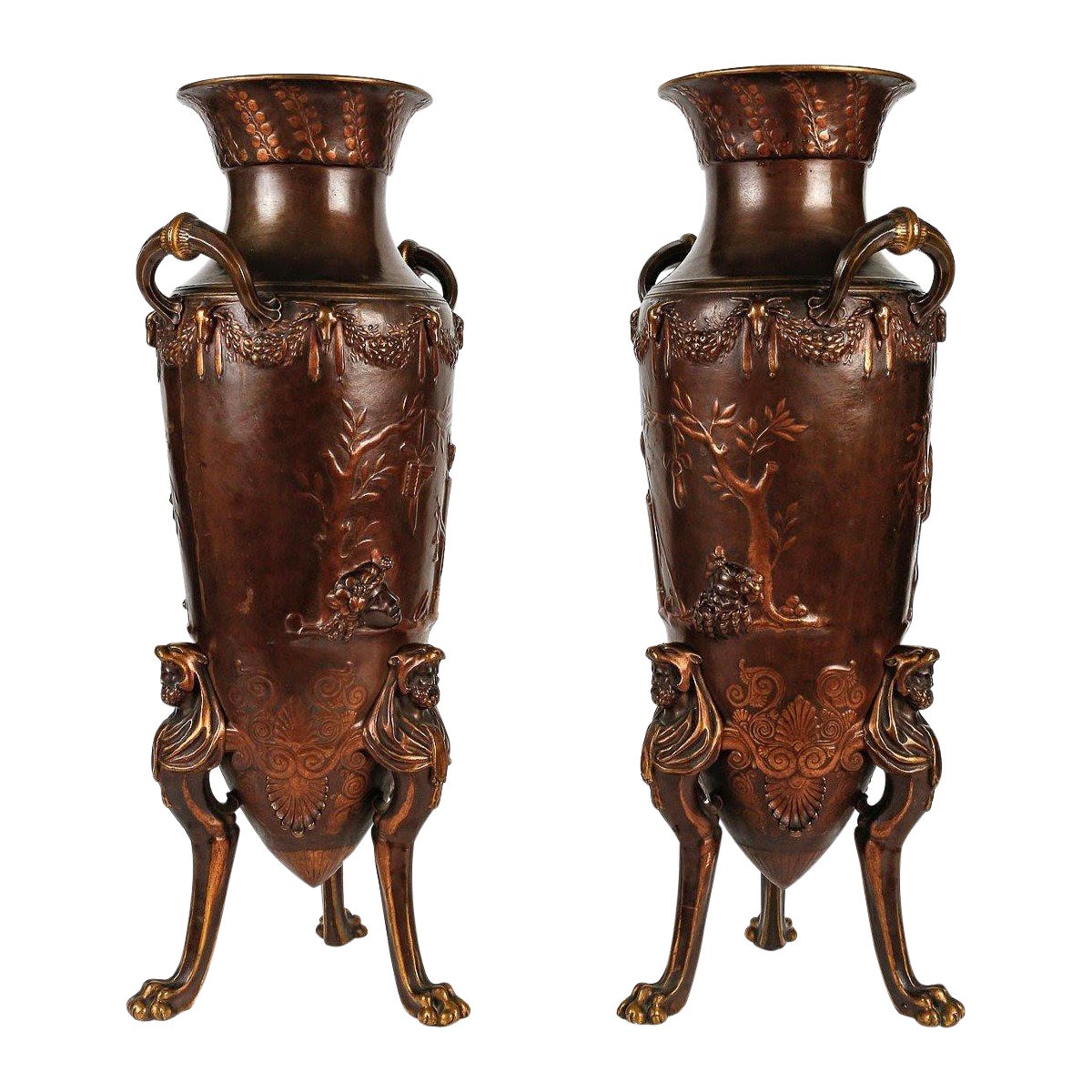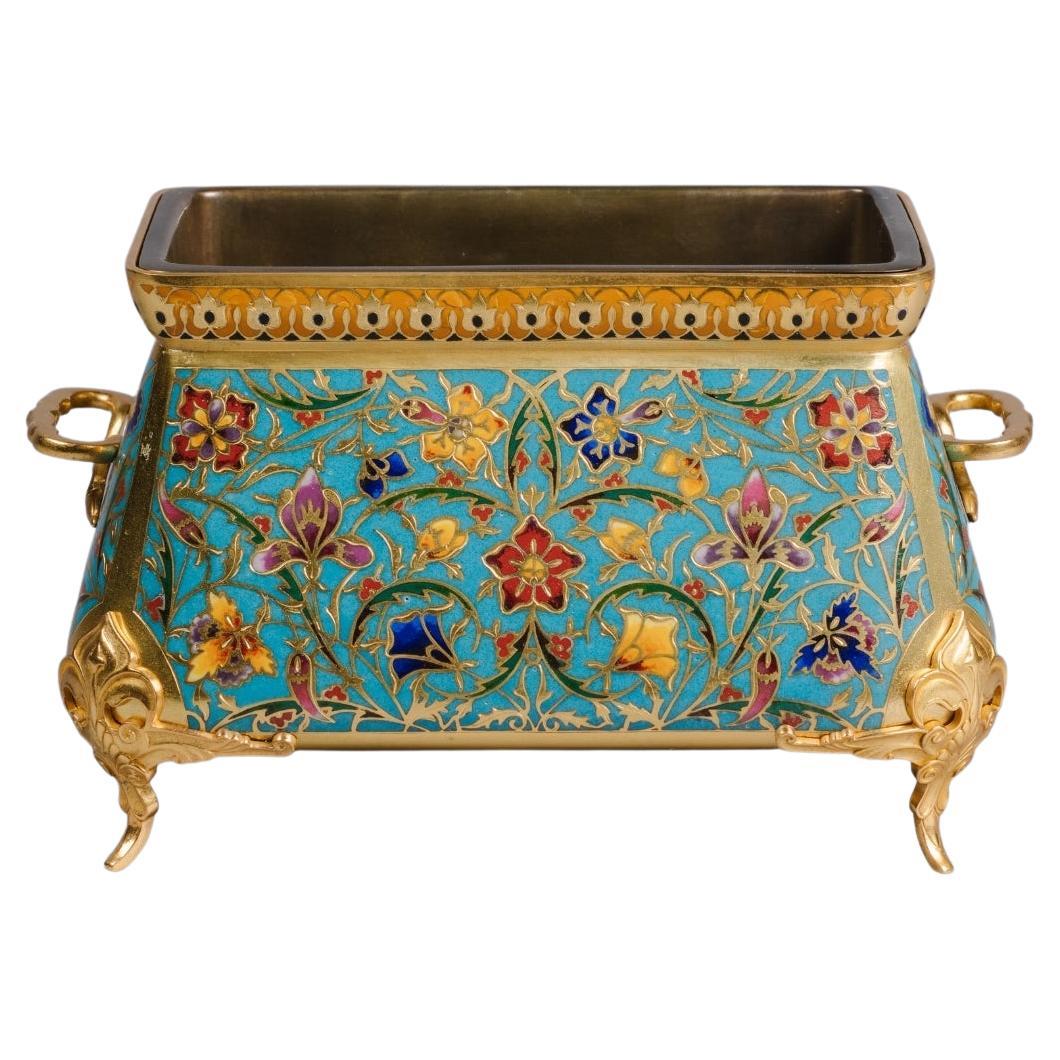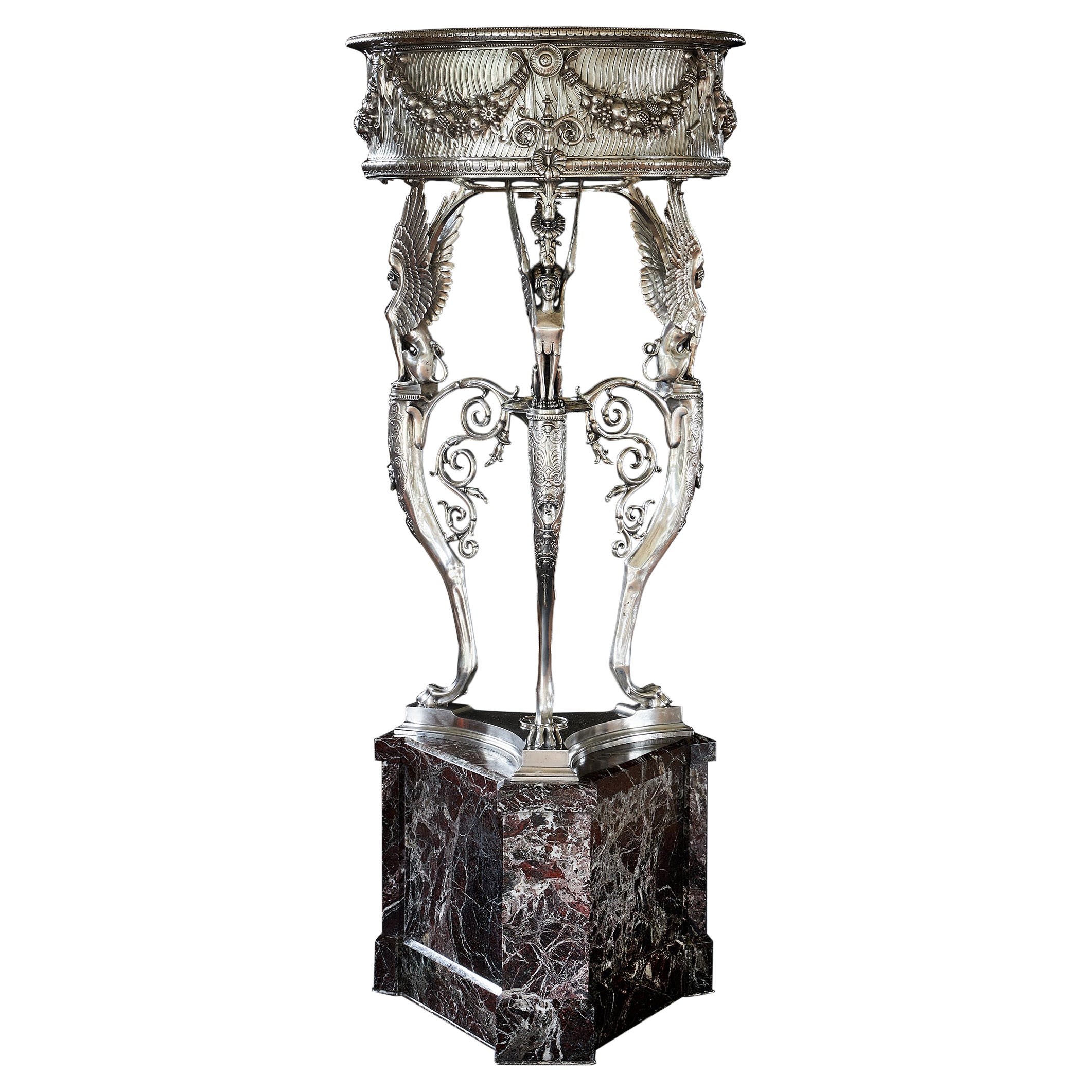Pair of Ferdinand Barbedienne Low Handled Bronze Borghese Urns
About the Item
- Creator:Ferdinand Barbedienne (Maker)
- Dimensions:Height: 5.71 in (14.5 cm)Width: 9.65 in (24.5 cm)Depth: 6.3 in (16 cm)
- Sold As:Set of 2
- Style:Classical Greek (In the Style Of)
- Materials and Techniques:Bronze,Metalwork
- Place of Origin:
- Period:
- Date of Manufacture:1870
- Condition:Wear consistent with age and use.
- Seller Location:Hastings, GB
- Reference Number:
Ferdinand Barbedienne
Founded by one-time Parisian wallpaper dealer Ferdinand Barbedienne and engineer Achille Collas, one of the most revered foundries in 19th-century France began with the invention of a revolutionary 1830s-era device that could produce proportional reproductions — large or small — of sculptures. Collas’s machine, which yielded miniature likenesses of antiquities for the interiors of homes the world over, was pivotal to the success of the F. Barbedienne Foundry. The successful firm earned prestigious awards and critical acclaim and created exquisite bronze candleholders, clocks and lamps for a range of wealthy and prominent clients.
The duo first launched their company under the name Société Collas et Barbedienne, and early on, they optimized chemical processes for pigmenting and patinating their bronze statuettes. After Collas died in 1859, Barbedienne forged on alone, and the company’s name changed to simply F. Barbedienne.
Barbedienne employed more than 300 workers at that point, and the Maison created a range of furnishings and decorative objects that featured the integration of marble and ormolu accents. However, with the onset of the Franco-Prussian War of 1870, the foundry was forced to retrofit its molds, and the production of cannons replaced sculptures, furniture and vases.
When Ferdinand Barbedienne passed away in 1891, his nephew and heir, Gustave Leblanc, took over as president, changing the name to Leblanc-Barbedienne. Leblanc expanded production into Germany, the United Kingdom and the United States, carrying on the company's legacy with monumental sculptures, and models and securing production rights for famous statues. Paul-Alexandre Dumas, an Art Nouveau maker and student of Louis Majorelle, succeeded Leblanc until the company's closing in 1952.
Barbedienne pieces had been exhibited regularly in the 19th century and were especially prevalent at Europe’s international expositions and world’s fairs, where they received numerous prizes. Today, the Musée d’Orsay in Paris holds dozens of Barbedienne works in its collection, including intricate mirrors, vases and cups created by Louis-Constant Sévin at the foundry. For more than two decades, Sévin created lamps, boxes and more at Maison Barbedienne. Working alongside award-winning chaser Désiré Attarge, Sévin designed Napoleon III-era works that greatly appealed to European nobility.
Other notable artists who collaborated with Barbedienne included Eugene Aizelin, Emmanuel Fremiet, Antonin Mercié, Emile Guillemin, Edouard Lievre, Ferdinand Levillain and Auguste Rodin.
On 1stDibs, find a collection of antique Ferdinand Barbedienne decorative objects, lighting and more.
- ShippingRetrieving quote...Ships From: Hastings, United Kingdom
- Return PolicyA return for this item may be initiated within 3 days of delivery.
- Pair of Victorian Carboys Late 19th CenturyLocated in Hastings, GBAn outstanding pair of hand blown Victorian Pharmacy Carboys, dating to around 1870 -1880, these were generally found in the window of Victorian chemists as a way of advertising thei...Category
Antique 19th Century English Victorian Bottles
MaterialsGlass
- 19th Century Green French Urn with HandlesLocated in Hastings, GB19th century French cast iron urn with decorative twin handles Bottle green with orangey colored undertones, stunning shape, 58cm width, 39cm depth, 32cm height.Category
Antique 19th Century French Napoleon III Urns
MaterialsIron
- Black French Cast Iron Urn with Decorative Handles, 19th CLocated in Hastings, GBA very beautiful 19th century French classical Urn, with highly decorative handles and detailed shape to the cast iron body. Dating to circa 1870 fi...Category
Antique 19th Century French Urns
MaterialsIron
- Pair of High Victorian Cast Iron Campana Urns on PlinthsLocated in Hastings, GBA matched pair of later Victorian cast iron Campana Urns on their original plinths in a beautifully worn deep green paint, circa 1880. Very old repair to the inside rim of one of the...Category
Antique 1880s English Regency Urns
MaterialsIron
- Metallic Gold Ceramano Vase, West GermanyBy CeramanoLocated in Hastings, GBMetallic gold Ceramano vase Stunning metallic finish Original sticker Model no: 271 Of all the West German manufacturers more is known about the glazes of Ceramano than any oth...Category
Mid-20th Century German Mid-Century Modern Vases
MaterialsCeramic
- E S Keramik Fat Lava Vase, West GermanyBy ES KeramikLocated in Hastings, GBE S Keramik fat lava vase 1921-1974 Good sized vase with Classic red patl shapes to the front and back Great condition Founded in Rheinbach in 1921 ...Category
Mid-20th Century German Mid-Century Modern Vases
MaterialsCeramic
- Ferdinand Barbedienne Set of Gilt Bronze-Mounted Champleve Onyx GarnitureBy Ferdinand BarbedienneLocated in Guaynabo, PRThis is a Ferdinand Barbedienne set of gilt bronze-mounted champleve onyx garniture. It consist of two urns and one large oval vase/jardiniere. The vase...Category
Antique Late 19th Century French Empire Garniture
MaterialsOnyx, Bronze
- A Pair of Patinated Bronze Vases by Ferdinand Barbedienne, 19th Century.Located in Saint-Ouen, FRA pair of patinated bronze vases by Ferdinand Barbedienne, 19th century. A pair of patinated bronze vases by Ferdinand Barbedienne in the taste of Ancient Greece. H: 57cm, D: 26cmCategory
Antique 19th Century French Classical Greek Vases
MaterialsBronze
- A Champlevé Enamel Jardinière by Ferdinand BarbedienneBy Ferdinand Barbedienne, Louis-Constant SevinLocated in Brighton, West SussexA Champlevé Enamel and Gilt-Bronze Mounted Jardinière by Ferdinand Barbedienne, the design attributed to Louis-Constant Sévin. This fine jardinière is decorated all over with foliate...Category
Antique 19th Century French Planters, Cachepots and Jardinières
MaterialsBronze, Enamel
- Extremely Rare Pair of Ferdinand Barbedienne Ormolu and Champlevé Enamel VasesBy Ferdinand Barbedienne, Louis-Constant SevinLocated in New York, NYAn extremely rare, museum quality pair of Ferdinand Barbedienne ormolu and champlevé enamel vases, circa 1870, certainly designed by Louis Constant Sevin...Category
Antique 19th Century French Napoleon III Vases
MaterialsEnamel, Ormolu
- 19th Century Silvered Bronze Athénienne Jardinière by Ferdinand BarbedienneBy Ferdinand BarbedienneLocated in Oxfordshire, United KingdomA French silvered-bronze athénienne by Ferdinand Barbedienne, Paris, last quarter 19th century with a revolving liner, the frieze applied with bucrania suspending ribbon-tied berried laurel swags above a border of bellflowers on a stippled ground above three seated female sphinxes issuing stylised foliage and scrolls on lion monopodia cast with the mask of Hercules, scrolling foliage and anthemions joined by stretchers, raised on a concave-sided triform marble base on a further thin silvered-bronze base, inscribed to the tripod base 'F. BARBEDIENNE' Measures: 103.3cm. high, 41.5cm. diameter; 3ft. 4 3/8 in, 1ft. 4 1/4. This impressive athénienne is a key reminder of the longevity of a particular model and design’s success from Antiquity through to the 19th century and up until this day. Typically known as the ‘Trépied du Temple d’Isis’, this athénienne is designed after the Roman antique originally found at Pompeii and now at the Museo Archeologico Nazionale, Naples (fig.1). From being for example an inspiration for the baptismal font of Napoléon’s son in 1811, this model was the inspiration to many highly skilled makers throughout the 19thcentury such as the Manfredini brothers from Milan and of course the Parisian well-established bronze founder Ferdinand Barbedienne who executed the present example. The Temple of Isis was a Roman temple dedicated to the Egyptian goddess Isis and was among one of the first discoveries during the excavation of Pompeii in 1764. Certainly considered as one of the most elegant examples of antique tripods, the existence of this model was then popularized to the rest of Europe via prints, one of the first being by Giovanni Battista Piranesi in 1779. This type of tripod was also popularised by an engraving in C. Percier and P. Fontaine’s, Receuil de Décorations Intérieures of 1801. Interestingly, there is also a watercolour now in the Musée Carnavalet, Paris, showing this type of tripod displayed at the 1801 Exposition des Produits de L’Industrie in the Louvre. The passion for Greek and Roman Art in the 19th century. The discovery of Pompeii and Herculaneum around the middle of the 18th century gave rise to a new passion for Antiquity and the excavated masterpieces renewed the repertoire of fine and decorative arts and served as models for Neoclassicism. Members of the aristocracy as well as connoisseurs, particularly in England, completed their education by undertaking a ‘Grand Tour’ of Italy and often fell victim to the recently unearthed Greek and Roman artefacts...Category
Antique 19th Century French Grand Tour Planters, Cachepots and Jardinières
MaterialsMarble, Silver Plate, Bronze
- Early 20th Century Gilt Bronze "Decorative Vases" by Ferdinand BarbedienneBy Ferdinand BarbedienneLocated in London, GBA highly attractive pair of late 19th century gilt bronze twin handled vases. The handles in the form of twisted vines and the vases decorated with butterflies and birds with snails ...Category
Early 20th Century French Art Nouveau Vases
MaterialsMarble, Gold, Bronze






